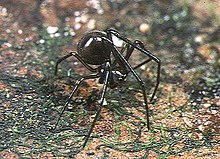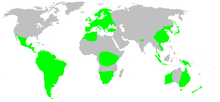| Anapidae Temporal range:
| |
|---|---|

| |
| C. lyugadinus, female from Okinawa | |

| |
| C. lyugadinus, male | |
| Scientific classification | |
| Domain: | Eukaryota |
| Kingdom: | Animalia |
| Phylum: | Arthropoda |
| Subphylum: | Chelicerata |
| Class: | Arachnida |
| Order: | Araneae |
| Infraorder: | Araneomorphae |
| Family: | Anapidae Simon, 1895 |
| Diversity | |
| 58 genera, 232 species | |

| |
| Synonyms | |
|
Micropholcommatidae | |
Anapidae is a family of rather small spiders with 232 described species in 58 genera.[1] It includes the former family Micropholcommatidae as the subfamily Micropholcommatinae,[2] and the former family Holarchaeidae. Most species are less than 2 millimetres (0.079 in) long.[3]
They generally live in leaf litter and moss on the floor of rain forest. Many build orb webs with a diameter less than 3 centimetres (1.2 in). In some species, such as P. parocula, the pedipalps of the female are reduced to coxal stumps.[3]
Description
[edit]Spiders of this family are very small, usually less than two millimeters long, and lack a cribellum. They can have either six or eight eyes, the rear median eyes either reduced or missing. The carapace is modified so that the eyes are raised higher than usual. Color can range from reddish brown to yellowish brown. Both margins of chelicerae have teeth. The legs are short and spineless. The labium has a spur that extends between the chelicerae and can be seen when the chelicerae are spread.[4]
Distribution
[edit]Anapidae are found worldwide, particularly in South America, Africa, Asia, Australia and New Zealand. Few genera occur in North America or Europe. Only Comaroma simoni and the three species of Zangherella are found in Europe; Gertschanapis shantzi and Comaroma mendocino are found in the United States.[5]
Systematics
[edit]The family Micropholcommatidae was synonymized with this family by Schütt in 2003[6] and by Lopa et al. in 2011,[7][2] a change that has been accepted by the World Spider Catalog.[5] Similarly, the family Holarchaeidae was synonymized by Dimitrov et al. in 2017, and likewise accepted by the World Spider Catalog.[8]
Genera
[edit]As of January 2023[update], the World Spider Catalog accepts the following genera:[1]
- Acrobleps Hickman, 1979 — Australia
- Algidiella Rix & Harvey, 2010 — New Zealand
- Anapis Simon, 1895 — South America, Central America, Mexico, Jamaica
- Anapisona Gertsch, 1941 — South America, Central America, Saint Vincent and the Grenadines, Mexico
- Austropholcomma Rix & Harvey, 2010 — Australia
- Borneanapis Snazell, 2009 — Indonesia
- Caledanapis Platnick & Forster, 1989 — New Caledonia
- Chasmocephalon O. Pickard-Cambridge, 1889 — Australia
- Comaroma Bertkau, 1889 — Asia, United States
- Conculus Kishida, 1940 — Papua New Guinea, Asia
- Crassanapis Platnick & Forster, 1989 — Chile, Argentina
- Crozetulus Hickman, 1939 — Africa
- Dippenaaria Wunderlich, 1995 — South Africa
- Elanapis Platnick & Forster, 1989 — Chile
- Enielkenie Ono, 2007 — Taiwan
- Eperiella Rix & Harvey, 2010 — Chile, Australia
- Epigastrina Rix & Harvey, 2010 — Australia
- Eterosonycha Butler, 1932 — Australia
- Forsteriola Brignoli, 1981 — Burundi, Rwanda, Congo
- Gaiziapis Miller, Griswold & Yin, 2009 — China
- Gertschanapis Platnick & Forster, 1990 — United States
- Gigiella Rix & Harvey, 2010 — Australia, Chile
- Guiniella Rix & Harvey, 2010 — Papua New Guinea
- Hickmanapis Platnick & Forster, 1989 — Australia
- Holarchaea Forster, 1955 — Australia, New Zealand
- Mandanapis Platnick & Forster, 1989 — New Caledonia
- Maxanapis Platnick & Forster, 1989 — Australia
- Metanapis Brignoli, 1981 — Africa, Nepal
- Micropholcomma Crosby & Bishop, 1927 — Australia
- Minanapis Platnick & Forster, 1989 — Chile, China, Argentina
- Montanapis Platnick & Forster, 1989 — New Caledonia
- Normplatnicka Rix & Harvey, 2010 — Australia, Chile
- Nortanapis Platnick & Forster, 1989 — Australia
- Novanapis Platnick & Forster, 1989 — New Zealand
- Octanapis Platnick & Forster, 1989 — Australia
- Olgania Hickman, 1979 — Australia
- Paranapis Platnick & Forster, 1989 — New Zealand
- Patelliella Rix & Harvey, 2010 — Australia
- Pecanapis Platnick & Forster, 1989 — Chile
- Pseudanapis Simon, 1905 — Asia, Germany, South America, Africa, Mexico, Central America, Papua New Guinea
- Pua Forster, 1959 — New Zealand
- Queenslanapis Platnick & Forster, 1989 — Australia
- Raveniella Rix & Harvey, 2010 — Australia
- Rayforstia Rix & Harvey, 2010 — New Zealand, Australia
- Risdonius Hickman, 1939 — Australia
- Sheranapis Platnick & Forster, 1989 — Chile
- Sinanapis Wunderlich & Song, 1995 — China, Laos, Vietnam
- Sofanapis Platnick & Forster, 1989 — Chile
- Spinanapis Platnick & Forster, 1989 — Australia
- Taliniella Rix & Harvey, 2010 — New Zealand
- Taphiassa Simon, 1880 — Australia, New Zealand, Sri Lanka
- Tasmanapis Platnick & Forster, 1989 — Australia
- Teutoniella Brignoli, 1981 — Chile, Brazil
- Tinytrella Rix & Harvey, 2010 — New Zealand
- Tricellina Forster & Platnick, 1989 — Chile
- Victanapis Platnick & Forster, 1989 — Australia
- Zangherella Caporiacco, 1949 — Europe, Algeria, Turkey
- Zealanapis Platnick & Forster, 1989 — New Zealand
See also
[edit]References
[edit]- ^ a b "Family: Anapidae Simon, 1895". World Spider Catalog. Natural History Museum Bern. Retrieved 2023-01-19.
- ^ a b Hormiga, Gustavo & Griswold, Charles E. (2014). "Systematics, Phylogeny, and Evolution of Orb-Weaving Spiders". Annual Review of Entomology. 59 (1): 487–512. doi:10.1146/annurev-ento-011613-162046. PMID 24160416.
- ^ a b Murphy, F; Murphy, J. (2000). "An introduction to the spiders of South East Asia with notes on all the genera". Malaysian Nature Society Kuala Lumpur.
- ^ Song, D.X.; Zhu, M.S.; Chen, J. (1999). The Spiders of China. Hebei University of Science and Technology, Publishing House, Shijiazhuang. p. 149.
- ^ a b "Family: Anapidae Simon, 1895". World Spider Catalog. Natural History Museum Bern. Retrieved 2017-03-03.
- ^ Schütt, K. (2003), "Phylogeny of Symphytognathidae", Zoologica Scripta, 32: 129–151, doi:10.1046/j.1463-6409.2003.00103.x, S2CID 84908326
- ^ Lopardo, L.; Giribet, G. & Hormiga, G. (2011), "Morphology to the rescue: molecular data and the signal of morphological characters in combined phylogenetic analyses — a case study from mysmenid spiders (Araneae, Mysmenidae), with comments on the evolution of web architecture", Cladistics, 27 (3): 278–330, doi:10.1111/j.1096-0031.2010.00332.x, PMID 34875780, S2CID 85647657
- ^ "Family: Holarchaeidae Forster & Platnick, 1984". World Spider Catalog. Natural History Museum Bern. Retrieved 2020-09-18.
Ramirez, M.J.; Platnick, N.I. (1999). "On Sofanapis antillanca (Araneae, Anapidae) as a kleptoparasite of austrochiline spiders (Araneae, Austrochilidae)" (PDF). Journal of Arachnology. 27 (2): 547–549.